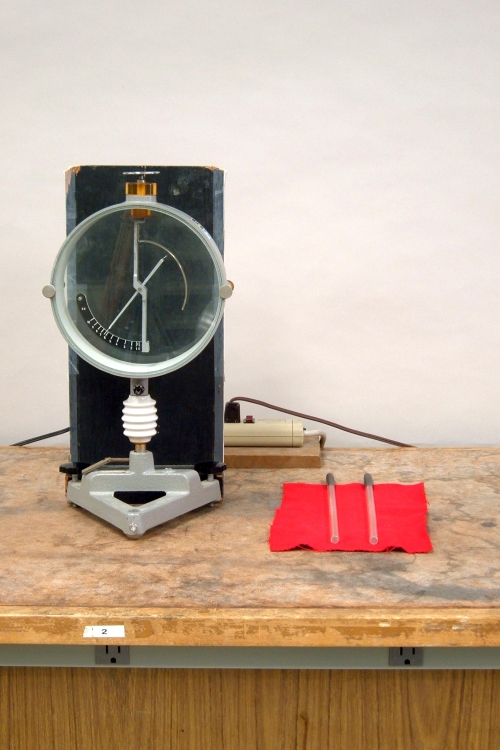
When you rub an electrically charged rod across the metal plate at the top of the electroscope, you transfer charge into the mechanism, and the needle deflects.
An electroscope is an instrument by means of which you can detect electric charge on an object. A common version of this instrument is the gold leaf electroscope, in which two very thin strips of gold foil hang from hooks at the bottom of a metal rod. The rod is mounted in the top of the case of the instrument via an insulating spacer, and usually has a ball electrode attached at the top. Charge deposited on the electrode distributes itself through the rod and the gold leaves. Since like charges repel (see demonstration 56.06 -- Electrostatically charged rods), the gold leaves, which hang vertically when there is no net charge on them, are now driven apart by electrostatic repulsion, and they splay.
The apparatus in this demonstration consists of a (metal) needle hung slightly above its center of mass by a pivot in the slot of a vertical metal frame. The frame hangs from metal hardware embedded in an insulating plug set in the top of the case of the electroscope, which has a receptacle for mounting an electrode such as the round plate shown above. When you rub the plastic rod with the wool cloth, it charges negative. When you stroke the rod on the plate at the top of the electroscope, you deposit negative charge in the assembly that comprises the electrode, needle and frame. Since the needle and frame now carry charge of the same sign, they repel each other, and the needle rotates. (An equal number of charges of the opposite sign builds up on the case of the electroscope. It is best that the case be connected to ground, but the case is large enough that the electroscope works well enough without this.)
The scale mounted to the bottom of the frame reads in kilovolts. The voltage across the electroscope (that is, between the innards and the case) is proportional to the charge deposited in it, and is V = Q/C, where Q is the charge, and C is the capacitance of the electroscope. (See demonstrations 60.12 -- Separating charged parallel plates, and 60.15 -- Variable capacitor to capacitance meter.) The capacitance of the electroscope measures 19.5 pF (picofarads). As we might guess from the equation above, the units of the farad are coulombs/volt. To charge the electroscope to 1 kV, then, we must deposit a charge of Q = CV = (1.95 × 10-11 C/V)(1,000 V) = 1.95 × 10-8 C, or 19.5 nC. The fundamental electric charge is 1.602 × 10-19 C, so this equals 1.95 × 10-8 C/(1.602 × 10-19 C/charge), or 1.22 × 1011 charges, or 122 billion charges. In the photograph above, the electroscope reads slightly above 6 kV, so it has somewhat more than 730 billion (negative) charges on the plate, needle and frame.
References:
1) Sears, Frances Weston and Zemansky, Mark W. College Physics, Third Edition (Reading, Massachusetts: Addison-Wesley Publishing Company, Inc., 1960) p. 515.